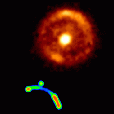


| |

| PRESS RELEASE - PR9801 27th March 1998 |
 |
Figure 1 Hubble and MERLIN image of 1938+666 A postscript version is available for Figure 1 |
 |
Figure 2 Diagram demonstrating the principle of a gravitational lens A postscript version is available for Figure 2 |
Click on these images for full size versions Background information is available HERE |
| Telephone: | 01477 571321 |
| FAX: | 01477 571618 |
| Address: | Nuffield Radio Astronomy Laboratories Jodrell Bank Macclesfield Cheshire SK11 9DL |
| Email: | njj@jb.man.ac.uk |
| Email: | pnw@jb.man.ac.uk |
NOTE: During the period Tuesday 31 March to Friday 3 April
Dr. Wilkinson will be attending the UK National Astronomy Meeting
(NAM) at the University of St. Andrews.
He can be contacted at via the NAM press room, whose hours are:
| Tuesday to Thursday, 8.30 - 18.00, and 9.00 - 12.00 Friday. | |
| Telephone: | 01334-462168 and 462169 |
| FAX: | 01334-463130 |
L.J. King et al. ``A complete infrared Einstein ring in the gravitational lens sytem B1938+666''
The MERLIN radio array is a UK National Facility operated by the University of Manchester on behalf of the Particle Physics and Astronomy Research Council. The Very Large Array is a US National Facility operated by the National Radio Astronomy Observatory on behalf of Associcated Universities Inc.
The astronomers involved work at the following institutes: University of Manchester; University of Oxford; California Institute of Technology (Pasadena); Netherlands Foundation for Radio Astronomy; University of Groningen; Institut d'Astrophysique de Paris.